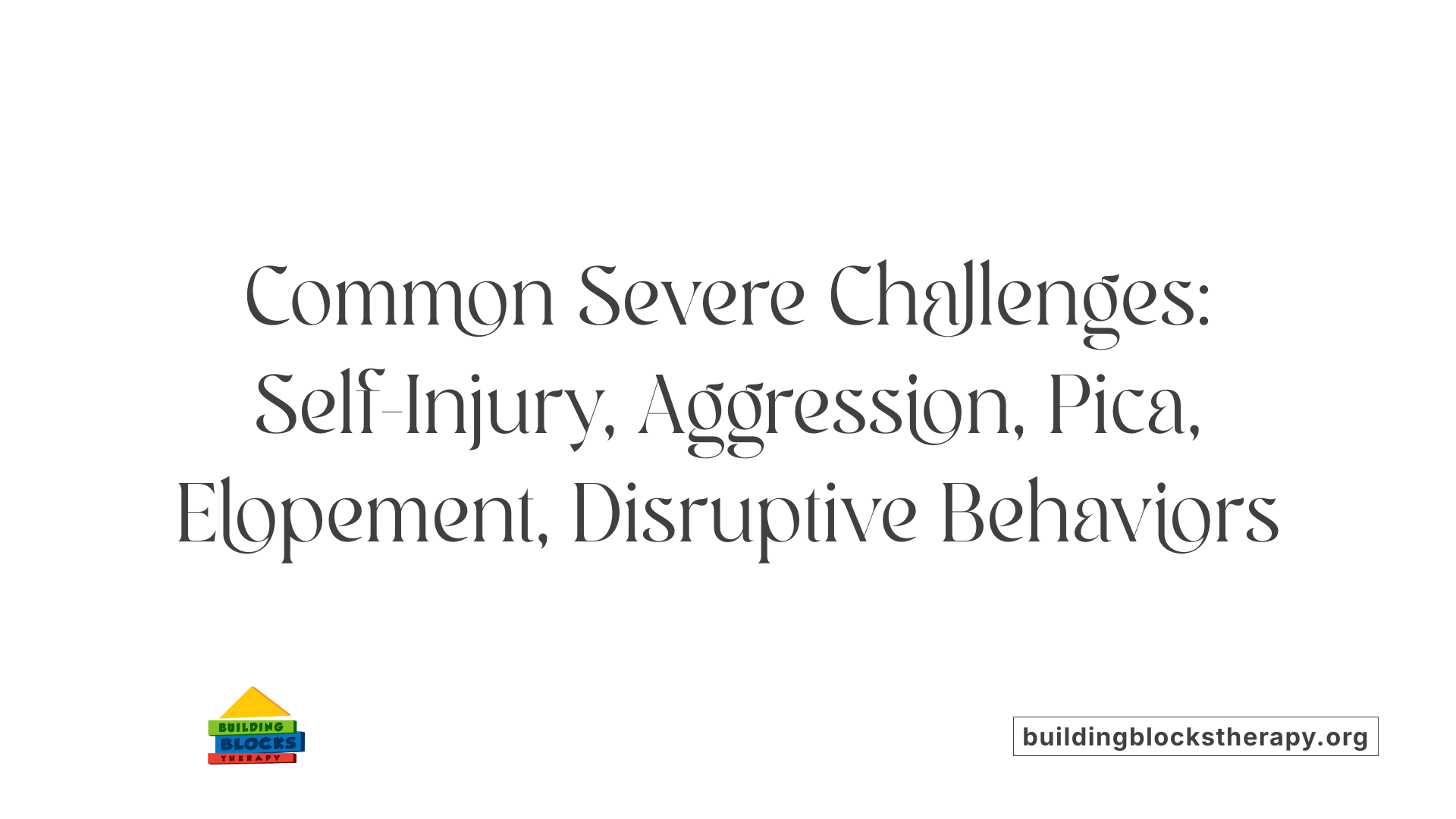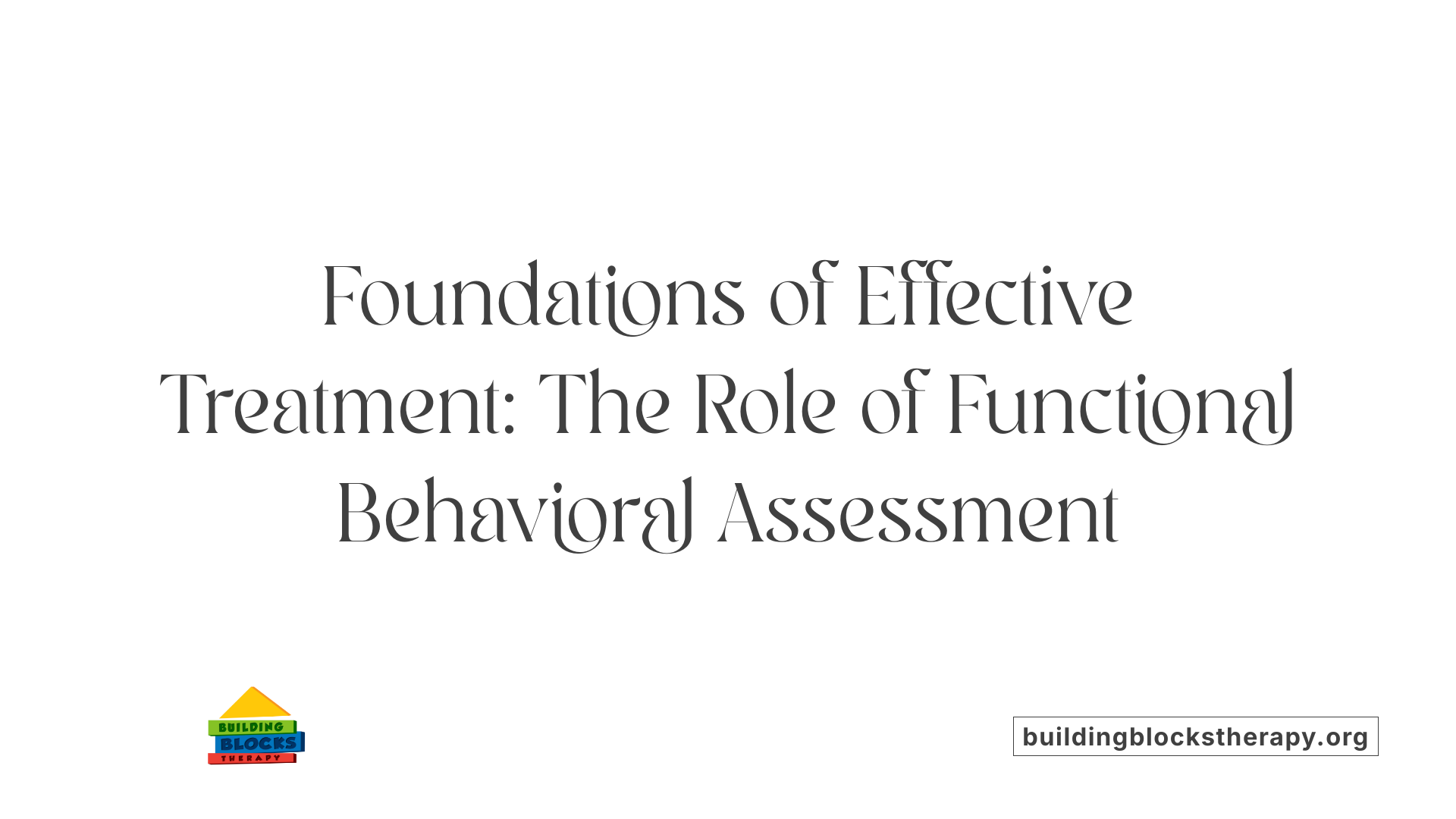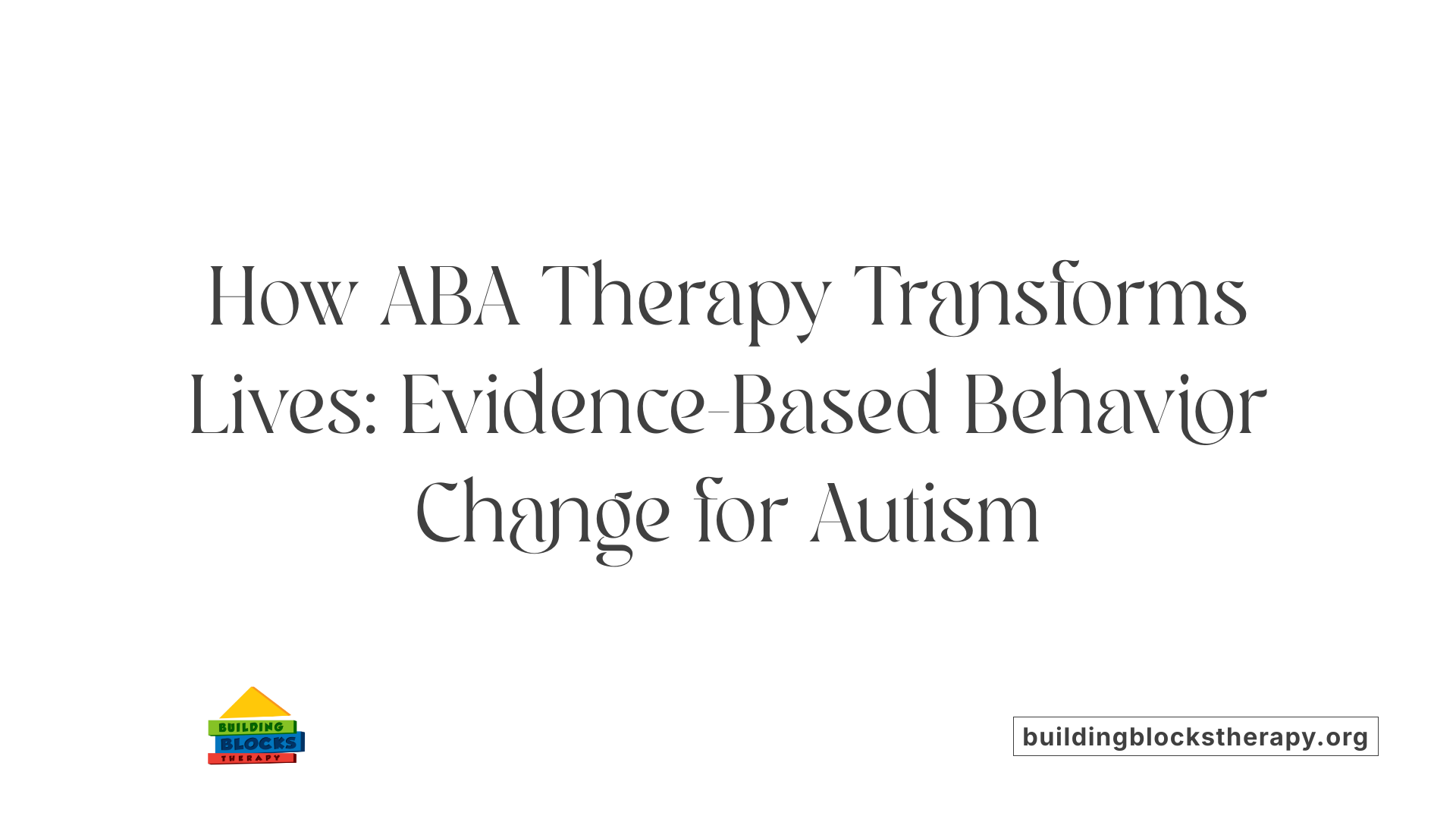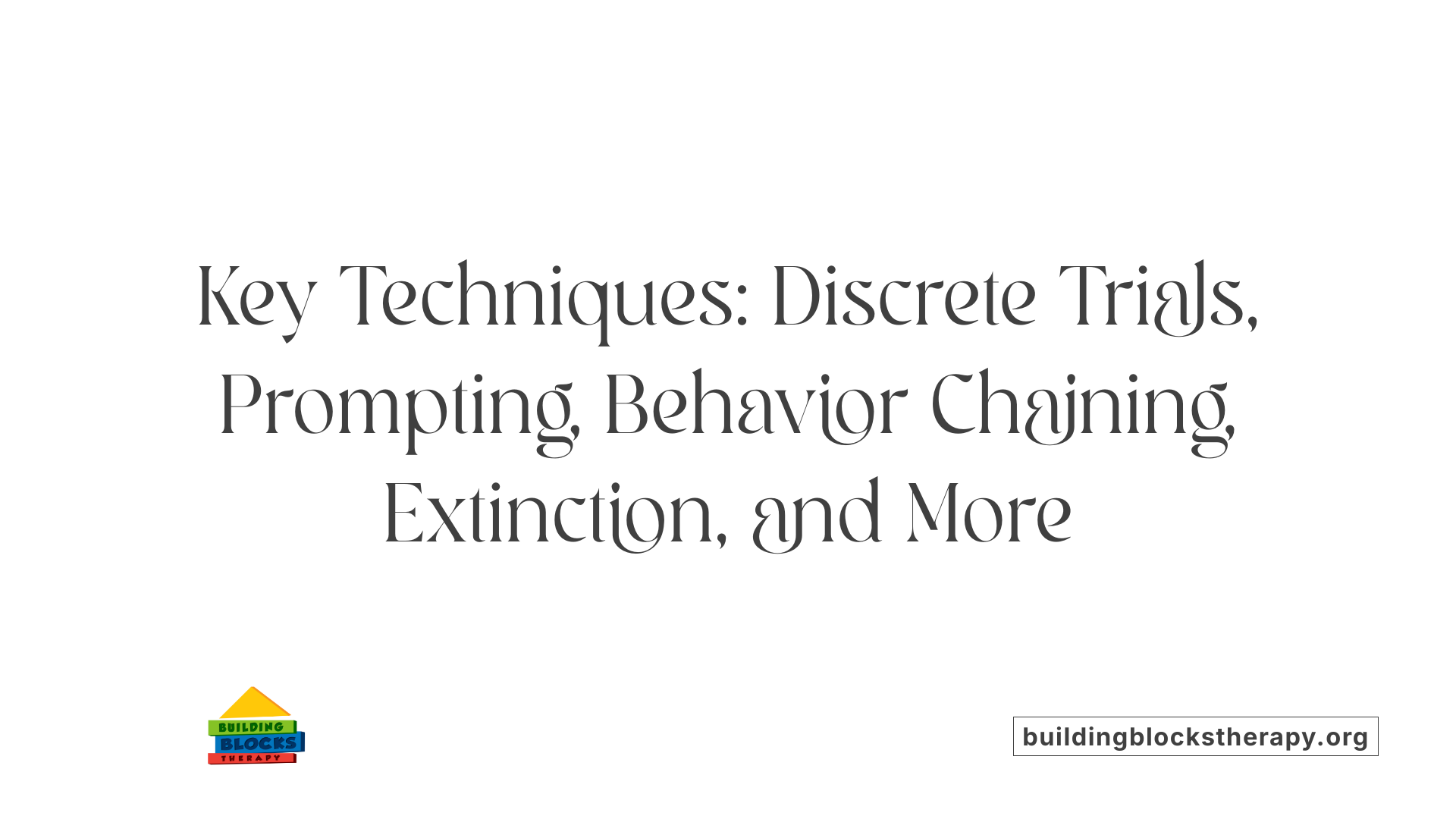Autism Severe Behavior Problems
Advancing Care for Severe Behavior Problems in Autism Spectrum Disorder

Understanding Severe Behavior Challenges in Autism
Children with Autism Spectrum Disorder (ASD), particularly those with intellectual disabilities (ID), frequently exhibit severe behavior problems such as self-injury, aggression, and disruptive actions. These behaviors can be chronic, impacting daily functioning and quality of life for both the individual and their families. This article explores the nature of these severe behaviors, current behavioral assessment strategies, treatment methods — most notably Applied Behavior Analysis (ABA) — and the roles of therapy providers in supporting individuals with autism to manage behavior challenges and improve their overall well-being.
The Complex Nature of Problem Behaviors in Autism

What types of severe behavior problems are common in children with ASD and intellectual disabilities?
Children diagnosed with Autism Spectrum Disorder (ASD) alongside intellectual disabilities (ID) frequently exhibit increased rates of severe behavioral challenges. These include self-injury, aggression towards others, pica (the consumption of non-food items), elopement (wandering away from safe environments), and various disruptive behaviors.
Characteristics and Prevalence of Severe Behaviors
These behaviors are often severe, persistent, and chronic. Their frequent occurrence can intensify the level of care and support required by affected individuals. The presence of intellectual disability alongside ASD appears to amplify the rate and intensity of these behaviors, underscoring the complexity of care needs.
Impact on Individuals and Families
Severe problem behaviors substantially interfere with the individual's daily functioning, potentially limiting social interaction, learning opportunities, and personal safety. For families, the demands of managing such persistent and disruptive behaviors can lead to increased stress and reduce overall family quality of life. The significant burden highlights the necessity for comprehensive assessment and individualized treatment planning.
Types of Problem Behaviors
- Self-injury: Behaviors where the individual causes physical harm to themselves, which can range from mild to severe.
- Aggression: Includes hitting, biting, or other physically harmful acts directed at others.
- Pica: Ingesting items that are not food, posing risks of poisoning or injury.
- Elopement: Leaving safe areas unexpectedly, creating safety hazards.
- Disruptive behavior: Various actions that interrupt normal activities or social settings.
Understanding these patterns helps tailor interventions to reduce harm and improve life quality for children with ASD and ID and their families.
Functional Behavioral Assessment: The Foundation for Effective Intervention

What is Functional Behavior Assessment and why is it important?
Functional Behavior Assessment (FBA) is a systematic process used to identify the specific environmental antecedents (triggers) and consequences that maintain problem behaviors, such as self-injury or aggression, especially in children with autism spectrum disorder (ASD) and intellectual disabilities (ID).
Role of Functional Behavior Assessment (FBA)
FBA plays a crucial role in understanding why a behavior occurs by analyzing its function. This emphasis on environmental factors allows clinicians to uncover the "why" behind a behavior. For example, a child might engage in aggressive behavior to seek attention or escape a challenging task.
Identifying antecedents and consequences
During FBA, professionals observe and collect data on what happens immediately before (antecedents) and after (consequences) the problem behavior. By uncovering patterns, they can determine if behaviors are maintained by factors such as gaining access to preferred items, avoiding demands, or sensory stimulation.
How FBA informs individualized treatment plans
Understanding the function of behaviors through FBA enables the creation of personalized intervention strategies. Treatments might involve modifying antecedents to prevent behavior triggers or reinforcing alternative, more appropriate communication skills. Functional analysis, a form of FBA that manipulates environmental conditions, further refines treatment by identifying the exact reinforcers maintaining the behavior.
By laying this foundation, FBA supports the development of targeted and effective treatments, such as Applied Behavior Analysis (ABA), that improve daily functioning and quality of life for children with ASD and ID.
Applied Behavior Analysis (ABA) Therapy: A Scientific Approach to Behavior Change

What is Applied Behavior Analysis (ABA) therapy, and how does it help individuals with autism?
Applied Behavior Analysis (ABA) therapy is a scientifically supported approach grounded in the principles of learning theory and operant conditioning. It focuses on understanding how behavior works, how it is influenced by the environment, and how learning occurs. ABA targets improving social, communication, and adaptive skills in individuals with autism spectrum disorder (ASD).
Definition and principles of ABA therapy
ABA therapy uses systematic techniques like positive reinforcement, where desired behaviors are rewarded to encourage their recurrence. Central to ABA is the 'A-B-Cs' model—antecedent, behavior, and consequence—which helps analyze the causes and effects of behaviors. Key methods include discrete trial training (DTT), which involves structured, step-by-step instruction, and pivotal response training (PRT), which emphasizes natural settings to develop crucial skills such as communication initiation.
How ABA helps individuals with autism
ABA therapy aims to increase helpful behaviors while decreasing harmful or disruptive behaviors, including aggression or self-injury. Therapists conduct functional behavioral assessments (FBA) to identify environmental factors influencing behaviors, then create individualized treatment plans. Early and intensive ABA interventions are shown to produce significant gains, enhancing language, social skills, memory, and academic abilities.
Aims and flexibility of ABA programs
ABA programs are highly adaptable, tailored to each individual's unique needs, and delivered across various settings including homes, schools, and communities. Treatments may be comprehensive—targeting a broad skillset—or focused on specific behaviors requiring intervention. Qualified professionals such as Board Certified Behavior Analysts (BCBAs) oversee these programs, ensuring ongoing assessment and adjustment based on collected data. The therapy's evidence-based approaches have earned endorsements by organizations like the US Surgeon General and the American Psychological Association, reflecting its established effectiveness in helping children with autism.
Key ABA Techniques in Managing Severe Behaviors

What are some common techniques used in ABA therapy for autism?
Applied Behavior Analysis (ABA) therapy uses a range of effective techniques to support individuals with autism in managing severe behaviors and acquiring new skills.
Discrete Trial Training (DTT) is a structured method where skills are taught in small, clear steps through repeated trials. Each trial includes a cue, the individual's response, and a consequence, often positive reinforcement, to encourage learning.
Prompting and fading guide learners toward the correct behavior by providing cues or assistance that are gradually reduced as independence increases.
Behavior chaining breaks complex skills into smaller parts taught in sequence, with reinforcement delivered after completing the chain to encourage successful task completion.
Extinction involves discontinuing reinforcement for problem behaviors, helping to reduce their occurrence over time by removing their maintaining consequences.
Natural Environment Teaching (NET) focuses on skill generalization by encouraging communication and social behaviors in everyday settings, making learning more meaningful and functional.
Additional tools include visual modeling, which uses images or videos to demonstrate desired behaviors, and response blocking, which prevents engagement in harmful behaviors like self-injury.
These techniques are customized based on functional behavior assessments to ensure interventions effectively address the individual's unique needs and promote positive behavior change.
The Role of Specialized Providers in Delivering ABA Therapy
Credentials and Roles of ABA Providers
ABA therapy is primarily delivered by qualified professionals trained in behavior analysis. Board Certified Behavior Analysts (BCBAs) lead the development and oversight of individualized treatment plans. They are often supported by Board Certified Assistant Behavior Analysts (BCaBAs) and Registered Behavior Technicians (RBTs), who implement therapy sessions under BCBA supervision. This team collaborates closely to assess and modify interventions based on ongoing data collection.
Settings Where ABA Is Delivered
ABA therapy is versatile and tailored to meet individual needs across various settings. It can be provided at home, offering a familiar environment for skill acquisition; at school, integrating learning within academic routines; or in community locations, facilitating socialization and generalization of skills. Flexibility in setting contributes to comprehensive treatment addressing both developmental and behavioral targets.
Family Involvement and Parent Training
Family participation is a cornerstone of effective ABA therapy. Qualified providers educate and empower caregivers through parent training programs like the RUBI Parent Training Program, which helps families reduce problem behaviors and promote daily living skills. This collaboration ensures strategies are consistently applied beyond therapy sessions, fostering a supportive environment that enhances child progress.
Access and Insurance Coverage
Access to ABA therapy depends on provider availability and insurance plans. Many providers are part of specialized organizations or networks that may accept private insurance and Medicaid, especially for children under 21 years of age. Families are encouraged to verify coverage, consult healthcare providers, and use resource guides to locate qualified ABA therapists. Understanding insurance limits and funding pathways is essential for obtaining continuous services.
The combination of specialized professionals, flexible delivery settings, active family involvement, and evolving insurance support forms the backbone of effective ABA therapy implementation for individuals with autism.
Evidence Supporting ABA Therapy and Its Impact on Quality of Life
How effective is ABA therapy in improving the quality of life for individuals with autism?
Applied Behavior Analysis (ABA) therapy is widely recognized as an effective intervention for children with autism spectrum disorder (ASD). Research demonstrates significant improvements in critical areas such as communication, social skills, and adaptive behaviors following ABA treatment. These advancements contribute directly to a better quality of life by enabling greater independence and more positive interactions in daily settings.
Research outcomes on ABA effectiveness
Studies, including early landmark research like the UCLA Young Autism Project, have shown that intensive ABA programs can lead to notable intellectual and educational gains. Meta-analyses further confirm that long-duration ABA interventions initiated in early childhood yield statistically significant improvements in language development, social functioning, and daily living skills.
Improvements in communication, social skills, and adaptive behaviors
ABA therapy enhances a wide range of skills: from communication—including alternatives such as signs and electronic devices—to social engagement and daily living tasks. Personalized treatment plans that incorporate techniques like discrete trial training and pivotal response training help achieve these gains by reinforcing desired behaviors and systematically teaching new skills.
Behavior reduction success
ABA also effectively decreases problem behaviors such as aggression, self-injury, and disruptive actions. Evidence-based strategies including extinction, functional communication training, and non-contingent reinforcement have achieved behavior reductions averaging over 90% in clinical studies, which greatly enhance safety and quality of life for individuals and their families.
Limitations and considerations for long-term impact
Despite strong evidence supporting short- to medium-term benefits, research on the long-term effects of ABA and its cost-effectiveness remains limited. Many studies utilize small sample sizes and single-case designs. There is a growing call for rigorous, large-scale prospective research that includes quality of life evaluations and comparisons with emerging therapies to establish standardized care benchmarks.
Overall, ABA therapy remains a cornerstone treatment for ASD, supported by decades of research and endorsed by authoritative organizations. Its ability to improve core skills while reducing challenging behaviors offers substantial promise for enhancing life quality, particularly when delivered intensively and in partnership with caregivers.
Advanced Behavioral Treatments: Skill-Based Treatment for Challenging Behaviors
What is skill-based treatment (SBT) and how does it address challenging behaviors in autism?
Skill-based treatment (SBT) is a specialized behavioral intervention designed to reduce challenging behaviors in children with autism spectrum disorder (ASD). It begins with a practical functional assessment (PFA), employing methods such as the interview-informed synthesized contingency analysis (IISCA) to identify the specific antecedents and consequences maintaining problematic behaviors. This individualized approach enables targeted and effective treatment planning.
SBT teaches individuals an omnibus functional communication response (FCR) that addresses multiple functions of challenging behaviors identified through IISCA—for example, behaviors maintained by escape or access to preferred items. This communication skill helps replace challenging behaviors with appropriate requests or responses, fostering better interaction and reducing distress.
Assessment methods like Interview-Informed Synthesized Contingency Analysis (IISCA)
IISCA is a refined functional assessment technique integrated within SBT. Unlike traditional assessments focusing on single contingencies, IISCA synthesizes multiple behavioral functions at once discovered during interviews with caregivers and observations. This comprehensive assessment identifies complex reasons behind challenging behaviors and informs the creation of effective, individualized communication strategies.
Functional communication responses (FCR)
A core element of SBT is teaching an omnibus FCR, a functional communication skill that meets several behavioral needs simultaneously. This approach ensures the individual can express multiple desires or escape requests in socially acceptable ways, significantly lowering the likelihood of challenging behaviors emerging to fulfill those needs.
Treatment components and trauma-informed care
SBT combines several established behavioral procedures, including:
- Functional communication training to teach replacement communication skills
- Extinction to reduce reinforcement of problem behavior
- Response chaining to build more complex appropriate behaviors from simpler ones
- Tolerance training to increase endurance for non-preferred situations
These techniques are delivered within a trauma-informed, patient-centered framework, meaning that care providers are sensitive to the individual's emotional and psychological safety. This approach also emphasizes collaboration with caregivers and adjustment based on ongoing assessment.
Research outcomes on behavior reduction
Research evidence demonstrates the effectiveness of SBT in substantially decreasing challenging behaviors in children with ASD. Studies report an average reduction of approximately 98.2% in problem behaviors after implementing SBT, signifying significant improvements in daily functioning and quality of life for affected children and their families.
| Aspect | Description | Significance |
|---|---|---|
| Assessment Method | Interview-Informed Synthesized Contingency Analysis (IISCA) | Identifies complex causes of problem behaviors efficiently |
| Communication Technique | Omnibus Functional Communication Response (FCR) | Addresses multiple behavioral needs simultaneously |
| Treatment Techniques | Functional Communication Training, Extinction, Response Chaining, Tolerance Training | Combines methods for comprehensive behavior reduction |
| Care Framework | Trauma-informed, patient-centered care | Ensures safety and individualized treatment environment |
| Outcomes | Average 98.2% reduction in challenging behaviors | Demonstrates high efficacy of SBT in practice |
Comprehensive and Multidisciplinary Approaches for Severe Cases
How are complex severe behaviors managed beyond outpatient ABA therapy?
Managing severe behavioral issues in children with autism spectrum disorder (ASD) and intellectual disability (ID) often requires approaches beyond standard outpatient applied behavior analysis (ABA) therapy. When problem behaviors such as self-injury, aggression, or elopement become severe or chronic, a multidisciplinary intensive treatment plan is frequently necessary. This plan may include combined behavioral and pharmacological interventions, particularly when biological factors or psychiatric conditions influence behavior. However, empirical support for pharmacological and behavioral combination therapies remains limited.
Combined behavioral and pharmacological treatments
Pharmacological treatments do not address core symptoms of ASD but can help manage co-occurring conditions like anxiety, high energy, and mood disorders that exacerbate challenging behaviors. In many cases, medications are used alongside behavioral therapies to improve safety and functional outcomes; however, this integrated approach typically requires careful monitoring and adjustment by clinicians.
Inpatient and intensive outpatient programs
For children with complex behavioral needs, such as frequent self-injury or severe aggression, specialized inpatient and intensive outpatient programs provide structured and comprehensive care. Programs like Neurobehavioral Units offer multidisciplinary treatment and extended support for safety, skill development, and behavioral reduction. These programs often allow flexible durations of therapy sessions to best meet individual needs.
Role of multidisciplinary teams including psychiatrists, speech therapists, and social workers
Multidisciplinary teams commonly comprise psychiatrists, Board Certified Behavior Analysts (BCBAs), medical providers, speech and language pathologists, educators, and social workers. This collaborative approach ensures the child’s medical, communicative, psychological, and educational needs are addressed holistically. Speech therapists help develop safer communication methods and skills; psychiatrists manage medically necessary treatments; social workers provide family support and resource coordination.
Coordination with schools and caregivers for holistic care
Effective treatment involves not only professionals but also the child’s caregivers and educational settings. Coordination with schools allows consistency in behavioral plans and supports generalization of learned skills across environments. Caregivers are engaged in planning and evaluation processes to promote positive behaviors and sustainability of interventions at home and in community settings.
These comprehensive and multidisciplinary approaches aim to improve quality of life for children with severe behavior challenges and their families by combining behavioral expertise, medical oversight, and educational support.
Complementary Interventions Supporting Autism Treatment Goals
Developmental Therapies: Speech and Language Therapy
Speech and language therapy plays a crucial role in supporting children with autism, helping improve their understanding and use of communication. This therapy accommodates a variety of communication methods, including verbal speech, signs, gestures, and electronic devices, tailoring to individual needs to enhance expressive and receptive language skills.
Occupational Therapy and Sensory Integration
Occupational therapy assists individuals in developing essential daily living skills like dressing, eating, bathing, and social interaction. It often includes sensory integration therapy, designed to address sensory processing issues where responses to sensory stimuli might be overwhelming or restrictive, thus improving the individual's ability to function comfortably in different environments.
Early Start Denver Model (ESDM)
ESDM is a developmental approach rooted in ABA principles and specifically designed for children aged 12 to 48 months. Using play and natural social interactions, ESDM focuses on improving language, social, and cognitive skills, making early intervention both effective and engaging.
Educational and Social-Relational Approaches
Programs like TEACCH provide structured routines and visual supports tailored for autistic learners, improving academic and daily living skills. Social-relational treatments, including DIR/Floor Time, Relationship Development Intervention (RDI), social stories, and social skills groups, center on enhancing social skills, emotional connections, communication, and overall social participation.
Use of Medications for Co-occurring Symptoms
While no medications treat core autism symptoms directly, pharmaceuticals can manage co-occurring issues such as high energy, attention difficulties, anxiety, depression, seizures, sleep disturbances, and gastrointestinal problems. Medication use is typically combined with behavioral and developmental therapies to address comprehensive treatment needs.
Family and Caregiver Involvement in Behavioral Interventions
Why is caregiver training important in managing problem behaviors?
Caregiver training programs, like the RUBI Parent Training Program, play a crucial role in managing problem behaviors in children with autism spectrum disorder (ASD). These programs equip families with practical strategies to reduce challenging behaviors such as hitting, kicking, tantrums, and noncompliance. By empowering caregivers, these approaches promote consistency and effectiveness of interventions applied in the home environment.
What strategies are taught for managing behavior at home?
Training often focuses on four main areas:
- Preventing problem behaviors before they start by modifying environments and routines
- Promoting positive behaviors through reinforcement and encouragement
- Responding effectively and consistently when challenging behaviors occur
- Teaching replacement skills that fulfill the same function as the problem behavior, such as communication
These strategies help caregivers create supportive settings where children can learn and practice new skills safely.
How does ongoing assessment and data collection support interventions?
Ongoing assessment is fundamental in behavioral interventions. Caregivers, often in collaboration with professionals, collect data on behavior frequency, triggers, and responses. This continuous monitoring allows for real-time adjustments to intervention plans, ensuring they remain effective and tailored to the child's evolving needs.
How does family involvement enhance skill generalization and quality of life?
Involving families ensures that newly acquired skills and positive behaviors generalize across settings and situations beyond the therapy sessions. This generalized learning substantially improves the child's daily functioning and overall quality of life. Moreover, when caregivers actively participate, they help maintain progress and foster stronger relationships within the family unit.
Together, caregiver training and involvement form an integral part of successful applied behavior analysis (ABA) interventions, bridging therapy and everyday life to support children's growth and well-being.
Toward Improved Outcomes for Autism and Severe Behavior Challenges
Addressing severe behavior problems in children with autism requires an integrated approach built on functional behavioral assessment and evidence-based interventions like Applied Behavior Analysis therapy. Tailored ABA programs led by qualified professionals employ diverse techniques to reduce problematic behaviors and promote adaptive skills, positively impacting individuals’ quality of life. Advanced treatments such as skill-based treatment and multidisciplinary teams support complex cases. Complementary therapies and active family involvement further enhance outcomes. Continued research to refine methodologies and expand long-term evidence will strengthen standards of care, ensuring individuals with autism can achieve their fullest potential with dignity and support.
References
- Treatment of severe problem behaviour in children with ...
- Applied Behavior Analysis (ABA)
- Treatment and Intervention for Autism Spectrum Disorder
- Therapies for Challenging Behaviors – Autism Center
- Applied Behavior Analysis in Children and Youth with ...
- Skill-based treatment for challenging behavior in autism ...
- Severe Behavior Disorders






